ROUNDUP and ROUNDDOWN in Excel are powerful functions that provide precise control over rounding numbers to specific decimal places. Whether you need to round up to the nearest whole number or round down to a specified number of decimal places, these functions offer flexibility and accuracy in data manipulation. By incorporating ROUNDUP and ROUNDDOWN in Excel into your formulas, you can ensure that your calculations meet the exact requirements of your analysis or reporting needs. These functions are particularly useful in financial modeling, statistical analysis, and any scenario where precision in rounding is essential. Mastering ROUNDUP and ROUNDDOWN in Excel empowers users to efficiently handle numerical data and produce reliable results in their spreadsheets. Whether you’re a financial analyst, data scientist, or business professional, understanding how to leverage ROUNDUP and ROUNDDOWN in Excel enhances your ability to work with numbers effectively and efficiently.
This Tutorial Covers:
- ROUNDUP Function
- Syntax of ROUNDUP Function
- Arguments of ROUNDUP Function
- Use of ROUNDUP Function in Excel
- Round a figure up to three decimal places
- Round a figure up to one decimal place
- Round a number up to the closest integer
- Round a figure up to the closest to 10
- Round a negative figure up to one decimal place
- Round a negative figure up to the closest integer
- ROUNDDOWN Function
- Syntax of ROUNDDOWN Function
- Arguments of ROUNDDOWN Function
- Use of ROUNDDOWN Function in Excel
- Round a figure down to three decimal places
- Round a figure down to one decimal place
- Round a number to the nearest integer
- Round a figure down to the nearest 10
- Round a negative figure down to one decimal place
- Round a negative figure down to the closest integer
1. ROUNDUP Function:
ROUNDUP is an Excel function that rounds a number up to a specified number of decimal places. This function always rounds up to the next highest number, even if the number is already at or above the midpoint between two possible rounding options. The ROUNDUP function is useful when you need to ensure that your results are always slightly higher than the actual value.
-
Syntax of ROUNDUP Function:
The Excel ROUNDUP function has the following syntax:
=ROUNDUP(number, num_digits)
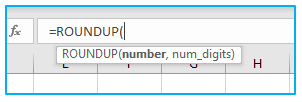
-
Arguments of ROUNDUP Function:
Here are the arguments for the ROUNDUP function:
number: This is the number you want to round up.
num_digits: This is the number of decimal places you want to round up to. It must be a whole number and can be positive or negative. If num_digits is positive, the number is rounded to that number of decimal places to the right of the decimal point. If num_digits is negative, the number is rounded to the left of the decimal point.
-
Use of ROUNDUP Function in Excel:
In Excel, the ROUNDUP function can be used to round numbers up to a specified number of decimal places. This section provides examples of how to use Excel ROUNDUP formula, including how to round up to a specific number of decimal places.
-
Round a figure up to three decimal places:
Suppose you have a dataset like the one below:

The steps to round a figure up to three decimal places are described below:
Step 1: Apply the below formula in cell E2 and you can either copy and paste the formula or drag the formula’s fill handle to the remaining cells.
=ROUNDUP(C2,3)
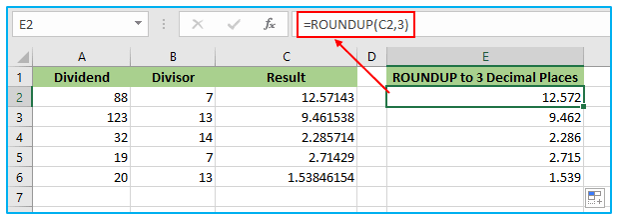
-
Round a figure up to one decimal place:
Suppose you have a dataset like the one below:

The steps to round a figure up to one decimal place are described below:
Step 1: Apply the below formula in cell E2 and you can either copy and paste the formula or drag the formula’s fill handle to the remaining cells.
=ROUNDUP(C2,1)
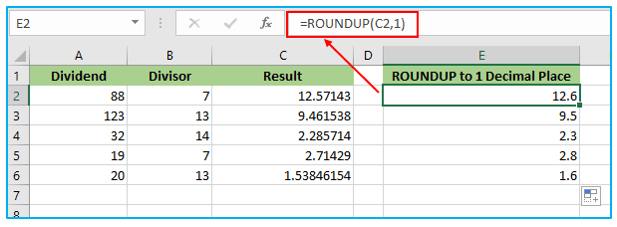
-
Round a number up to the closest integer:
Suppose you have a dataset like the one below:

The steps to round a number up to the closest integer are described below:
Step 1: Apply the below formula in cell E2 and you can either copy and paste the formula or drag the formula’s fill handle to the remaining cells.
=ROUNDUP(C2,0)
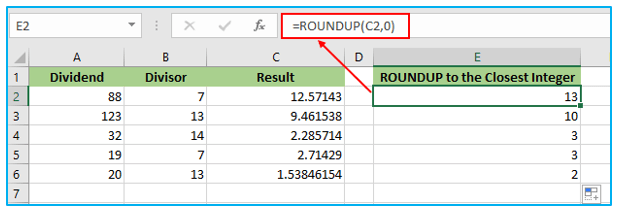
-
Round a figure up to the closest to 10:
Suppose you have a dataset like the one below:

The steps to round a figure up to the closest to 10 are described below:
Step 1: Apply the below formula in cell E2 and you can either copy and paste the formula or drag the formula’s fill handle to the remaining cells.
=ROUNDUP(C2,-1)
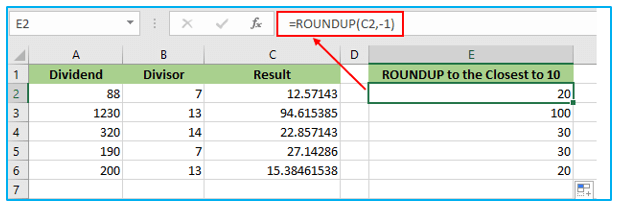
-
Round a negative figure up to one decimal place:
Suppose you have a dataset like the one below:

The steps to round a negative figure up to one decimal place are described below:
Step 1: Apply the below formula in cell E2 and you can either copy and paste the formula or drag the formula’s fill handle to the remaining cells.
=ROUNDUP(C2,1)

-
Round a negative figure up to the closest integer:
Suppose you have a dataset like the one below:

The steps to round a negative figure up to the closest integer are described below:
Step 1: Apply the below formula in cell E2 and you can either copy and paste the formula or drag the formula’s fill handle to the remaining cells.
=ROUNDUP(C2,0)

2. ROUNDDOWN Function:
ROUNDDOWN is an Excel function that rounds a number down to a specified number of decimal places. This function always rounds down to the next lowest number, even if the number is already at or below the midpoint between two possible rounding options. The Excel ROUNDDOWN function is useful when you need to ensure that your results are always slightly lower than the actual value.
-
Syntax of ROUNDDOWN Function:
Excel’s ROUNDDOWN function has the following syntax:
=ROUNDDOWN(number, num_digits)

-
Arguments of ROUNDDOWN Function:
Here are the arguments for the ROUNDDOWN function:
number: This is the number you want to round down.
num_digits: This is the number of decimal places you want to round down to. It must be a whole number and can be positive or negative. If num_digits is positive, the number is rounded to that number of decimal places to the right of the decimal point. If num_digits is negative, the number is rounded to the left of the decimal point.
-
Use of ROUNDDOWN Function in Excel:
The ROUNDDOWN function in Excel rounds numbers down to a specified number of decimal places. This function is useful when you need to ensure that your results are always slightly lower than the actual value. In this section, we provide examples of how to use the Excel ROUNDDOWN formula, including how to round down to a specific number of decimal places.
-
Round a figure down to three decimal places:
Suppose you have a dataset like the one below:

The steps to round a figure down to three decimal places are described below:
Step 1: Apply the below formula in cell E2 and you can either copy and paste the formula or drag the formula’s fill handle to the remaining cells.
=ROUNDDOWN(C2,3)
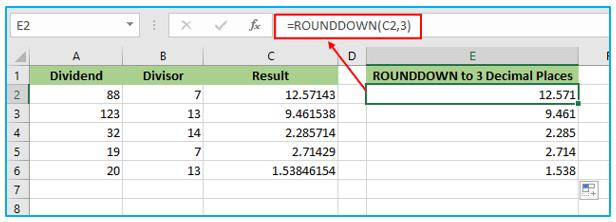
-
Round a figure down to one decimal place:
Suppose you have a dataset like the one below:

The steps to round a figure down to one decimal place are described below:
Step 1: Apply the below formula in cell E2 and you can either copy and paste the formula or drag the formula’s fill handle to the remaining cells.
=ROUNDDOWN(C2,1)

-
Round a number to the nearest integer:
Suppose you have a dataset like the one below:

The steps to round a number down to the closest integer are described below:
Step 1: Apply the below formula in cell E2 and you can either copy and paste the formula or drag the formula’s fill handle to the remaining cells.
=ROUNDDOWN(C2,0)

-
Round a figure down to the nearest 10:
Suppose you have a dataset like the one below:

The steps to round a number down to the nearest 10 are described below:
Step 1: Apply the below formula in cell E2 and you can either copy and paste the formula or drag the formula’s fill handle to the remaining cells.
=ROUNDDOWN(C2,-1)
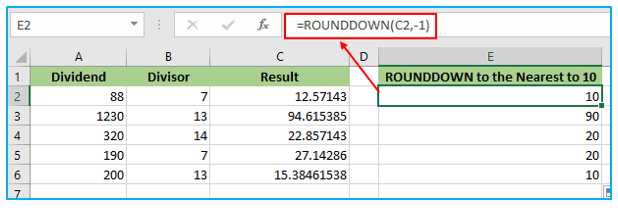
-
Round a negative figure down to one decimal place:
Suppose you have a dataset like the one below:

The steps to round a negative figure down to one decimal place are described below:
Step 1: Apply the below formula in cell E2 and you can either copy and paste the formula or drag the formula’s fill handle to the remaining cells.
=ROUNDDOWN(C2,1)

-
Round a negative figure down to the closest integer:
Suppose you have a dataset like the one below:

The steps to round a negative figure down to the closest integer are described below:
Step 1: Apply the below formula in cell E2 and you can either copy and paste the formula or drag the formula’s fill handle to the remaining cells.
=ROUNDDOWN(C2,0)

To round integers up or down to a specific number of decimal places, Excel’s ROUNDUP and ROUNDDOWN functions are effective tools. They are especially helpful if you want to make sure that your results are always a little bit higher or lower than the actual value, respectively. You ought to now be more familiar with how to apply these functions in your own Excel worksheets after carefully studying the examples given in this tutorial. Regardless of your level of experience, being able to use these features efficiently will enable you to make time savings and deliver more accurate outcomes in your work.
Application of ROUNDUP and ROUNDDOWN in excel
- Financial Modeling: Adjust financial projections or calculations to desired precision.
- Statistical Analysis: Round numerical data to specified decimal places for statistical reporting.
- Invoice Generation: Ensure accurate billing amounts by rounding prices to the nearest dollar or cent.
- Grade Calculation: Round student scores to the nearest whole number for grading purposes.
- Inventory Management: Round quantities of stock or inventory to whole numbers for tracking purposes.
- Budgeting: Round expense or revenue figures to manageable amounts for budget planning and analysis.
For ready-to-use Dashboard Templates:
